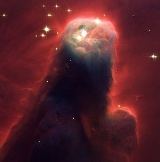
Cone Nebula
Encyclopedia
The Cone Nebula is an H II region
in the constellation of Monoceros. It was discovered by William Herschel
on December 26, 1785, at which time he designated it H V.27. The nebula
is located about 800 parsec
s or 2,600 light-year
s away from Earth
. The Cone Nebula forms part of the nebulosity surrounding the Christmas Tree Cluster. The designation of NGC 2264 in the New General Catalogue
refers to both objects and not the nebula alone.
The diffuse Cone Nebula, so named because of its apparent shape, lies in the southern part of NGC 2264
, the northern part being the magnitude-3.9 Christmas Tree Cluster. It is in the northern part of Monoceros
, just north of the midpoint of a line from Procyon
to Betelgeuse
.
The cone's shape comes from a dark absorption nebula consisting of cold molecular hydrogen and dust in front of a faint emission nebula
containing hydrogen ionized by S Monocerotis
, the brightest star of NGC 2264. The faint nebula is approximately seven light-years long (with an apparent length of 10 arcminutes), and is 2,700 light-years away from Earth.
The nebula is part of a much larger star-forming complex—the Hubble Space Telescope
was used to capture images of forming stars in 1997.
The nebula is sometimes referred to as the Jesus Christ Nebula because of its resemblance to Jesus with his hands in a prayer position.
H II region
An H II region is a large, low-density cloud of partially ionized gas in which star formation has recently taken place. The short-lived, blue stars forged in these regions emit copious amounts of ultraviolet light, ionizing the surrounding gas...
in the constellation of Monoceros. It was discovered by William Herschel
William Herschel
Sir Frederick William Herschel, KH, FRS, German: Friedrich Wilhelm Herschel was a German-born British astronomer, technical expert, and composer. Born in Hanover, Wilhelm first followed his father into the Military Band of Hanover, but emigrated to Britain at age 19...
on December 26, 1785, at which time he designated it H V.27. The nebula
Nebula
A nebula is an interstellar cloud of dust, hydrogen gas, helium gas and other ionized gases...
is located about 800 parsec
Parsec
The parsec is a unit of length used in astronomy. It is about 3.26 light-years, or just under 31 trillion kilometres ....
s or 2,600 light-year
Light-year
A light-year, also light year or lightyear is a unit of length, equal to just under 10 trillion kilometres...
s away from Earth
Earth
Earth is the third planet from the Sun, and the densest and fifth-largest of the eight planets in the Solar System. It is also the largest of the Solar System's four terrestrial planets...
. The Cone Nebula forms part of the nebulosity surrounding the Christmas Tree Cluster. The designation of NGC 2264 in the New General Catalogue
New General Catalogue
The New General Catalogue of Nebulae and Clusters of Stars is a well-known catalogue of deep sky objects in astronomy. It contains 7,840 objects, known as the NGC objects...
refers to both objects and not the nebula alone.
The diffuse Cone Nebula, so named because of its apparent shape, lies in the southern part of NGC 2264
NGC 2264
NGC 2264 is the designation number of the New General Catalogue that identifies two astronomical objects as a single object:*the Cone Nebula,*the Christmas Tree Cluster,Two other objects are within this designation but not officially included:...
, the northern part being the magnitude-3.9 Christmas Tree Cluster. It is in the northern part of Monoceros
Monoceros
Monoceros is a faint constellation on the celestial equator. Its name is Greek for unicorn. Its definition is attributed to the 17th-century Dutch cartographer Petrus Plancius. It is bordered by Orion to the west, Gemini to the north, Canis Major to the south and Hydra to the east...
, just north of the midpoint of a line from Procyon
Procyon
Procyon is the brightest star in the constellation Canis Minor. To the naked eye, it appears to be a single star, the seventh brightest in the night sky with a visual apparent magnitude of 0.34...
to Betelgeuse
Betelgeuse
Betelgeuse, also known by its Bayer designation Alpha Orionis , is the eighth brightest star in the night sky and second brightest star in the constellation of Orion, outshining its neighbour Rigel only rarely...
.
The cone's shape comes from a dark absorption nebula consisting of cold molecular hydrogen and dust in front of a faint emission nebula
Emission nebula
An emission nebula is a cloud of ionized gas emitting light of various colors. The most common source of ionization is high-energy photons emitted from a nearby hot star...
containing hydrogen ionized by S Monocerotis
S Monocerotis
S Monocerotis, also known as 15 Monocerotis, is a massive variable star system located in the constellation Monoceros. It is a spectroscopic binary system with an orbital...
, the brightest star of NGC 2264. The faint nebula is approximately seven light-years long (with an apparent length of 10 arcminutes), and is 2,700 light-years away from Earth.
The nebula is part of a much larger star-forming complex—the Hubble Space Telescope
Hubble Space Telescope
The Hubble Space Telescope is a space telescope that was carried into orbit by a Space Shuttle in 1990 and remains in operation. A 2.4 meter aperture telescope in low Earth orbit, Hubble's four main instruments observe in the near ultraviolet, visible, and near infrared...
was used to capture images of forming stars in 1997.
The nebula is sometimes referred to as the Jesus Christ Nebula because of its resemblance to Jesus with his hands in a prayer position.

